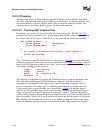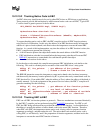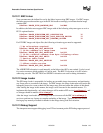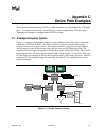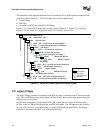
Version 1.10 12/01/02 A-1
Appendix A
GUID and Time Formats
All EFI GUIDs (Globally Unique Identifiers) have the format described in Appendix J of the
Wired for Management Baseline Specification. This document references the format of the GUID,
but implementers must reference the Wired for Management specifications for algorithms to
generate GUIDs. The following table defines the format of an EFI GUID (128 bits).
Table A-1. EFI GUID Format
Mnemonic
Byte
Offset
Byte
Length
Description
TimeLow 0 4 The low field of the timestamp.
TimeMid 4 2 The middle field of the timestamp.
TimeHighAndVersion 6 2 The high field of the timestamp multiplexed with the
version number.
ClockSeqHighAndReserved 8 1 The high field of the clock sequence multiplexed with
the variant.
ClockSeqLow 9 1 The low field of the clock sequence.
Node 10 6 The spatially unique node identifier. This can be
based on any IEEE 802 address obtained from a
network card. If no network card exists in the system,
a cryptographic-quality random number can be used.
All EFI time is stored in the format described by Appendix J of the Wired for Management
Baseline Specification. This appendix for GUID defines a 60-bit timestamp format that is used to
generate the GUID. All EFI time information is stored in 64-bit structures that contain the
following format: The timestamp is a 60-bit value that is represented by Coordinated Universal
Time (UTC) as a count of 100-nanosecond intervals since 00:00:00.00, 15 October 1582 (the date
of Gregorian reform to the Christian calendar). This time value will not roll over until the year
3400 AD. It is assumed that a future version of the EFI specification can deal with the year-3400
issue by extending this format if necessary.






